New Jersey approves first solar installations on preserved farms
BY DEBORAH BOWERS, Editor & Publisher
TRENTON, NJ– The State Agriculture Development Committee (SADC) approved June 23 the first applications for installation of solar units on preserved farms. The three approved applications are for units that are roof-mounted on existing buildings. Rules have not yet been completed for ground-mounted structures.
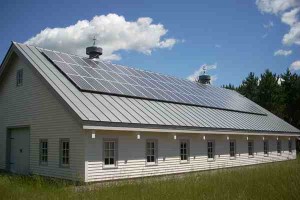
Roof mounted solar installation (Photo courtesy of Wis.-based Northwind Renewable Energy LLC)
The SADC acted on the applications under a law passed last year that allows alternative energy systems to be installed on farms. Its proposed rules were released for comment early this year.
The rooftop generation systems range in size from 17 to 40 kilowatts, according to Hope Gruzlovic of the SADC.
SADC approved rules in May that set standards for commercial farms to qualify for right-to-farm protection for energy generation operations on New Jersey farms, as directed under the law passed last year, and it will be developing rules specifically for preserved farms as required under the law. The rules will become effective upon publication, anticipated late this summer.
In addition to operating the farmland preservation program, SADC administers the state’s right to farm law and was charged with developing rules for adding energy generation as a protected use.
According to SADC, farms seeking right-to-farm protection must conform to the newly developed standards as well as meet the eligibility criteria for farmland assessment. These include that for every acre devoted to energy generation, another five acres of land must be devoted to agricultural/horticultural operations; the total area devoted to energy generation cannot exceed 10 acres and no more than two megawatts of power may be generated.
The New Jersey law allowing energy generation on farms, including preserved farms, was signed into law in Jan 2010. Under the law, energy generation on preserved farms will be allowed to exceed farm use by 10 percent, or alternatively, the plant will be allowed to occupy up to one percent of the land. Farm owners will be required to own the facility and can sell excess generation to reduce energy costs on the farm through net metering. Under New Jersey law, net metering allows excess generation to be credited to the customer’s next bill at the retail rate.
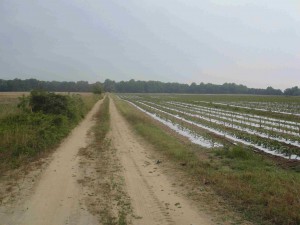
NJ preserved farm (Photo: SADC)
Coinciding with passage of the energy law, the legislature also amended the state’s use value assessment law to include biomass, solar or wind energy generation. SADC executive director Susan Payne said adding energy production under use value taxation was distinguishable from redefining agriculture or even agricultural use generally. She told FPR in Feb. 2010 the new law “acknowledges that alternative energy generation is something that can happen to a limited degree” without turning a farm into a power station. It is a subtle distinction, she added, between allowing, for taxation purposes, the inclusion of energy production as an agricultural use, and changing the state’s definition of agricultural use.
SADC strongly objected to changing the definition of agriculture or agricultural use when the bill was first introduced in 2008.
The law states that no income from power or heat sold from biomass, solar, or wind energy generation may be considered income for eligibility for valuation, assessment and taxation.
Legislation ties Pa. program funding with gas drilling tax
BY DEBORAH BOWERS, Editor & Publisher
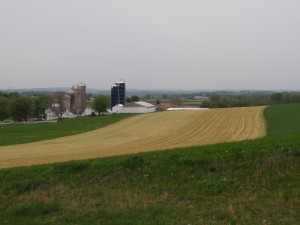
Pennsylvania farmland (FPR photo)
HARRISBURG, PA – One of Pennsylvania’s two dedicated sources of money for farmland preservation has dried up and one bill introduced in the legislature would replenish those dollars by taxing the state’s fast growing Marcellus shale gas drilling industry.
Legislation introduced by Rep. Kate Harper, who represents parts of Montgomery County, would create a severance tax on gas extraction, which has become the hottest economic boost in recent history in the state. Drilling in the Marcellus shale regions that stretch across the western and northern parts of the state has changed the rural economic landscape. According to Harper, and the bill’s 18 cosponsors, it is time for the gas drilling industry to pay into a fund to address the negative impacts the change has brought about. Those include water pollution, wildlife habitat destruction and damage and wear on local and state infrastructure. Pennyslvania has not imposed a tax on the drilling industry.
The Environmental Stewardship Fund (ESF), whose monies came through the state’s Growing Greener II initiative passed by voters in 2005, provided $80 million for farmland preservation. Now, the farmland program must rely more heavily on its other dedicated fund, a portion of the state cigarette tax revenue that earmarks at least $20 million to farmland preservation annually.
A coalition of organizations supports renewing the Growing Greener initiatives with $200 million annually. The coalition also is urging the state to stop using the ESF to pay the debt service on Growing Greener bonds.
With ESF funds spent, the cigarette tax funding will remain as the program’s major funding source, said Doug Wolfgang, director of the Bureau of Farmland Preservation. Wolfgang said the program also gets some monies from a rollback tax imposed on lands enrolled in the state’s Clean and Green program, which taxes agricultural land at its use value. The program also receives federal funds from the Farm and Ranchland Protection Program.
“There’s always a need for additional funding,” Wolfgang said.
A loss of funding will impact and likely enlarge the program’s 2000-farm backlog, comprising approximately 240,000 acres. Since the program’s beginning, the average per acre payment has been $2500.
According to the Marcellus Shale Coalition, an industry group, drilling companies have been paying for their wear on local roads, spending more than $400 million to repair roadways they use. Under state law, companies log which roads are used and must provide a plan for maintaining the roads.
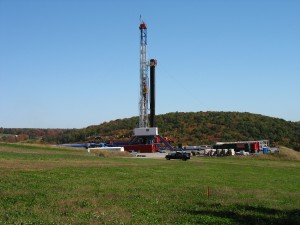
Marcellus gas drilling site (Credit: Pa. DEP)
Under the Harper bill, HB 1406, 36 percent of revenues from the severance tax would go to environmental programs including the ESF. The tax would equal 1.5 percent of the gross value of gas units extracted for the first 60 months of production and 5 percent of the gross value of units taken thereafter on wells that produce natural gas in excess of 90,000 cubic feet per day. According to Harper, the bill was modeled after a similar tax enacted in Arkansas.
“The money would go to local communities to help them deal with the effects of a heavy industry moving in,” said Rep. Harper on her website. She said every other state with active gas drilling has a severance tax. “Pennsylvania is remiss in not having this industry pay its fair share.” She said she and her cosponsors do not believe that the tax will make drilling companies go away.
A bill in the Senate, SB 1100, would impose graduated impact fees on natural gas extraction with revenues targeted to community services and conservation districts.
Since 2005, the state Department of Environmental Protection, Bureau of Oil and Gas Management, has issued 7,560 permits for Marcellus shale drilling, and 3,329 have been drilled. Of that number, 745 wells have been drilled in 2011. From Jan. through May 2011, the Bureau issued 1,367 permits for Marcellus shale drilling in northern and western parts of the state; 654 wells were drilled during the period. Bradford, Tioga and Lycoming counties lead the state in number of wells drilled and permits issued. Bradford had 158 Marcellus wells drilled as of April; Tioga had 101, and Lycoming 96.
Gov. Tom Corbett opposes levying a severance tax, stating it would hurt the booming economy that the gas drilling has created, which is indirectly boosting tax revenues. Corbett said gas drillers would work in other states if Pennsylvania levied its own severance tax. A recent poll found that Pennsylvania voters support taxing drilling companies by 69 percent to 24 percent. The legislature debated levying a severance tax during budget negotiations that are ending with passage of a budget by the end of June. But the severance tax push will continue.
House agriculture spending bill slashes conservation programs
BY DEBORAH BOWERS
WASHINGTON, D.C. – The House passed the FY2012 agriculture budget June 16 at $7 billion less than requested by the president, including $770 million for conservation programs, a nearly $1 billion decrease in spending over last year.

Wetlands Reserve project, Wisconsin (Photo by NRCS-Wis.)
According to the Land Trust Alliance, the House bill funds the Farm and Ranchlands Protection Program at $150 million, a cut of $25 million over last year and $50 million less than authorized in the 2008 farm bill.
The American Farmland Trust and the Land Trust Alliance are urging their members to call their senators to ask that funding be restored.
Rep. Jack Kingston of Georgia, subcommittee chairman on agriculture appropriations, said the House-approved budget for agriculture as a whole is a reduction of 13.4 percent in discretionary funding and “makes the tough choices necessary to reduce spending while keeping our bill’s basic missions of food production, food and drug safety, rural development and nutrition programs intact.” Kingston said the Committee worked “where possible” with the Agriculture Committee “to identify and initiate major reforms for the upcoming Farm Bill.”
“We realize that Congress faces tough budget choices, but making draconian cuts to voluntary conservation programs that help farmers and ranchers provide all Americans with cleaner air and water, more productive soils and habitat for wildlife is penny-wise and dollar-foolish,” said Sara Hopper, agricultural policy director for Environmental Defense Fund (EDF) and a former staff member of the Senate Agriculture Committee. “The Senate needs to restore reasonable funding levels for conservation programs for the benefit of our environment and taxpayers.”
Fifty organizations including the American Farmland Trust, Land Trust Alliance and the EDF, opposed the proposed cuts May 31 in a joint letter stating conservation programs “are crucial to the health and viability of agriculture and rural America” that “deliver demonstrated environmental benefits including clean air, clean water, and abundant habitat for wildlife. They protect soil and farmland to provide lasting food security. And they bring important money and jobs to rural areas…”
Conservation funding in the farm bill supports a number of federal programs that use conservation easements to protect agricultural and natural lands in cooperation with state and local land protection programs. Those programs, administed by the Natural Resources Conservation Service (NRCS) include the Farm and Ranchland Protection Program; the Grassland Reserve Program; the Emergency Watershed Protection Program, which purchases floodplain easements; the Healthy Forests Reserve Program; and the Wetlands Reserve Program.
Harford program back after three-year hiatus
BY DEBORAH BOWERS, Editor & Publisher
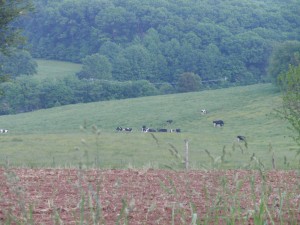
Preserved farm in Harford (FPR photo)
BEL AIR, MD – Applicants to Harford County’s local farmland preservation program have been waiting three years for funding to become available again following the economic downturn that pinched revenues from the county’s local real estate transfer tax. They got their wish a few months ago when the county announced it would have $3 million to use for the program. Sixty applicants are under consideration in the new round.
“We’re going to treasury and the county executive to get them ranked. In about mid-July we should have it hammered down and start making offers,” said Bill Amoss, program administrator. After offers are accepted, proposed purchases will go before the Harford County Council sometime in October, he said.
In Harford’s last round, finished in 2008, per-acre offers ranged between approximately $9000 and $13,000. But this new round will cap per-acre offers at $7000, Amoss said. In addition, in this round the county will not offer the option of lump sum payment as in past rounds. All applicants will be offered an installment purchase arrangement.
“That will help stretch the money to get to more of our 60 applicants,” said Amoss. He didn’t know how many would receive offers. “They are all nice properties.”
Just six years ago the Harford program had to increase its offer range because a cap of $5000 per acre was keeping applicants away, with about 12 offers turned down. But the installment purchase agreement (IPA) aspect of the program also kept potential applicants away from the Maryland state program operated by the Md. Agricultural Land Preservation Foundation, because the advantages of the county’s IPA were well understood by Harford’s farmers. The prospect of capital gains tax deferral and tax-free interest payments was preferred to the state program’s lump sum payout.

New home construction in rural Harford in 2011. This new home is part of a six-lot subdivision next to a preserved farm. (FPR photo)
The presence of a major military installation that is host to personnel transfers under the Base Realignment and Closure (BRAC) Act has kept Harford County from experiencing the level of real estate downturn in other Maryland localities. New home construction and lot sales in the county’s rural areas continued with many homes going up next to preserved farms. Even so, officials said transfer tax revenues slowed to a point that the farmland program had to be put on ice for several years to allow revenues to accumulate for a new round. During that period, revenues were adequate only to pay the interest on installment purchases completed in prior years, county officials said.
Harford’s program began in 1993 when the county council passed legislation that allowed for installment payments to be made in government real estate transactions. The program rapidly became a national leader and since has preserved over 40,000 acres. Once an agricultural powerhouse that led the nation with its number of canneries, Harford’s coastal plain soils along the top of the Chesapeake Bay have had the fate of hosting not only a large military reservation but industrial and office development county leaders favored over agriculture.
Harford’s program currently ranks 9th in the nation for number of acres preserved. Under the latest USDA agricultural census, its value of agricultural products was reported at about $43 million. The county’s agricultural zoning, restricting density to 1:10, has been rated as ineffective.
Filmaker George Lucas helps preserve Marin County ranch
POINT REYES STATION, CA — Lucasfilm Foundation, the charity founded by filmmaker George Lucas, this spring provided $2 million to Marin Agricultural Land Trust (MALT) to preserve the 1,214-acre Corda Ranch just west of Novato. The remainder of the $2.9 purchase was provided by the federal Farm and Ranch Lands Protection Program through NRCS.
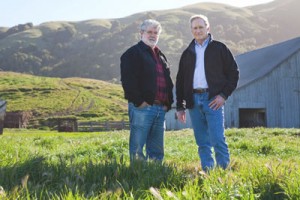
George Lucas, left, with MALT director Bob Berner at the Corda ranch
The easement will help the fifth-generation Corda family stay in agricultural production. The easement also protects the headwaters of Novato Creek, the primary tributary of Stafford Lake, an important part of Novato’s water supply.
George Lucas has taken an active interest in the landscape of Marin since bringing his Lucasfilm operations to Skywalker Ranch near Nicasio in the late 1970’s. Skywalker Properties owns several ranches in the area covering more than 6,100 acres, most of which are protected by MALT agricultural conservation easements.
“As a long-time resident of Marin, the county’s natural open spaces are very important to me,” Lucas explained in a MALT press release. “Since we first made the move here in 1979, we’ve always worked to preserve the landscape and the environment. We need to respect and protect the land while we’re here, so that future generations can also appreciate its beauties and its benefits.”
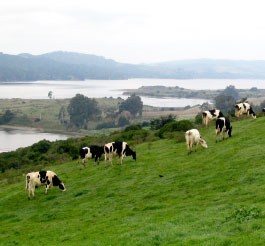
A scenic Marin dairy farm
“The farms and ranches of Marin are an important resource for the entire Bay Area,” Lucas continued. “By supporting MALT’’s protection of the Corda Ranch, we’re helping to ensure that these diverse habitats are monitored and well-managed now and in the future.”
Since its founding in 1980, MALT has permanently protected more than 40 percent of the private family farm and ranch land in Marin County.
Robert Berner, Executive Director at MALT, explained the importance of protecting agricultural properties such as the Corda Ranch, saying, “Family farms and ranches in Marin face tremendous pressure to give in to residential development. Large properties such as the Corda Ranch are threatened as the market for country-style luxury homes and estates keeps increasing. By permanently preserving this ranch for agricultural uses, we’re helping to maintain the critical mass of farming operations required to sustain agriculture as a viable component of Marin County’s economy for generations to come.”
The Corda family has owned the ranch since the early 1900’s. Agricultural operations on the ranch include raising beef cattle and dairy heifers, as well as silage crop production for a local dairy. According to MALT, without the sale of a conservation easement, the family would have likely been forced to subdivide the ranch and sell parcels to settle estate issues.
“Our family has been tending this land for over a hundred years,” said Fred Corda, who will retain ownership of the property, along with his wife and two adult sons, and continue agricultural operations. “I’m sure that in the beginning, no one ever dreamed that property values would grow so high and the pressure to sell would be so great. But now, thanks to MALT, we know this ranch will always be protected for agriculture, and that’s really important to us as stewards of the land.”
MALT is a member-supported, nonprofit organization created in 1980 by a coalition of ranchers and environmentalists to permanently preserve Marin County farmland. Some of the Bay Area’s most highly acclaimed dairy products and organic crops are produced on farmland protected by MALT conservation easements, which total more than 42,300 acres on 67 family farms and ranches.
This story was provided by MALT in a press release.
Planning was my profession, but farmland preservation is my love
BY MIKE MCGRATH, Contributing Editor

Mike McGrath
Thirty-eight years ago I climbed down off a tractor and went to work for the New Castle County government. Where did my parents go wrong? Seriously, I’ve not regretted a minute of the time as I look forward to retiring from the State of Delaware at the end of June. I did tell every boss that I worked for, “If you want to fire me, let me know in January.” “Why” “Because, then at least, I can buy some seed and get a crop in the ground!” Farming was a passion I inherited – saving farmland I had to learn.
It’s been a good run here at the Delaware Agricultural Lands Preservation Foundation in the Department of Agriculture. With over 100,000 acres of Delaware farmland permanently preserved I feel as though I’ve done what I came here to do 28 years ago. I’m the only person who has ever managed ag preservation in Delaware. Like Ted Williams’ home run in his last at-bat, I wanted to leave public service on a high note – I think I’m doing that.
Planning has always been my profession – away from the farm. At the very heart of farmland preservation is good planning. Many people talk about maintaining a local food supply, or insuring the local ag economy, or supporting the noble profession of farming as reasons for putting public money and effort towards preserving farmland. Those are all good reasons. But at its very heart farmland preservation has always been, for all those reasons and many more, just plain, good planning. Preserving farmland complements good urban planning, too. It’s all part of what every jurisdiction should be doing as one of its principal goals – solid planning. In the 1950s, when “Holly” Whyte (famous, then, as author of The Organization Man and with a definite Delaware connection as a graduate of St. Andrew’s School in Middletown) advocated for preserving farmland through placing conservation easements on prime land, it was really part of his wider vision for planning in New York City. In 1972 Whyte wrote the text for the NYC Plan. Later, Whyte became famous for his insistence on street level plans that reflected humans’ actual activities. The connection is obvious – eating and farming are the most basic of human activities and should be at the very base of the plans we make for our civilization. The Greeks and Romans made the farmers’ marketplace (agricola) the centerpiece of their city plans. William Penn, another great city planner (and planter!) established farmers’ markets in his plans for Wilmington, Delaware. Only recently are we re-discovering the proper role of farmland and markets in our plans. I hope it’s not too late.

McGrath at Gettysburg Roundtable dinner, 2008 (FPR photo)
But preserving farmland has been my passion. Ultimately, the value of preserving farmland is a personal matter. As much as anyone in this business I’ve tried to use statistics, analysis, facts to justify the permanent protection of farms for future generations. In the final analysis, though, I have found that the public, and most farmers, have a deep-seated commitment to protecting the land that transcends numbers. While I can justify marriage (most days!) by citing the tax code, or longevity statistics, or basic economics, at the end of the day I’ve stayed with Joan for nearly forty years because I love her so much. That’s been the case with preserving farmland, too. I love doing it! I love seeing the face of an octogenarian who walks in to permanently preserve his great-grandfather’s farm. I love handing a settlement check to a young couple who are committed to farming a piece of land for a lifetime. I love it when someone who just bought a farm signs an easement and says, “Well, this farm will never be developed!” I don’t know exactly why I love all these things – but I do!
When I left home at 18 my father had a few words of advice. Fathers always do, don’t they? He said, “Whatever you decide to do with your life, try to make it something you would do even if they wouldn’t pay you for doing it.” Dad always said his vegetable farming and greenhouses were his hobbies – and he made money, too. I think I’ve done the same thing with my career. They’ve paid me pretty well for pursuing my passion. Not a bad deal! I can only wish the same for you in your career!
From the Publisher: Congratulations, Mike! We all wish you a long and happy retirement. But we look forward to your continued words of wisdom here at FPR! – Deborah B. Mike can be reached until June 30 at michael.mcgrath@state.de.us. After June 30 he can be reached at mhmcgrath@gmail.com
“Sustainable farming takes root in agriculture”
BY BOB HEUER, Contributing Editor
“Sustainable farming takes root in agriculture.”
That’s the headline of a recent front page San Francisco Chronicle story.
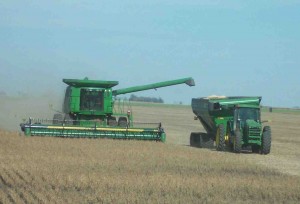
Conventional agriculture and fossil fuels at work
The Chronicle’s Washington correspondent Carolyn Lochhead has reported on the “conventional” versus “alternative” farming debate for many years. She wrote this story because public interest in food, farming and agriculture reform is “gaining real momentum from even a year ago, reaching a critical mass. The rewrite of the federal farm bill will see these forces play out with much greater intensity than the 2008 bill, especially given the enormous budget pressures.”
Carolyn’s article explores the ideological battle dividing large- and small-scale agriculture and makes the case for co-existence. The story presents perspectives from numerous sources—including me.
Having tracked federal Farm Bills since 1990 first as a reporter and now as a consultant, I think profitability must remain the core principle of “sustainable agriculture.” Nothing really new there. What’s changed is the increasingly irrefutable need to factor external environmental, social and economic costs into the equation. How this gets done will depend a lot on dialogue and the creation of mutually acceptable measures to incrementally improve sustainability outcomes.
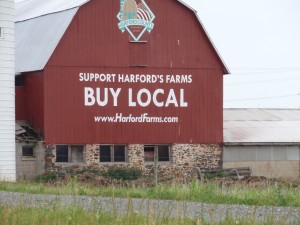
Local governments are sponsoring the 'buy local' message to support their local ag economy (FPR photo)
I’ve never seen such a good conversation starter as “local” food. Growing demand for food sourced from nearby farms is obviously a criticism of the industrial farm and food model, but this need not be the cause for a culture war.
A big part of the solution will come from “conventional” farmers and ranchers who learn to accommodate ideological differences. One farmer told me recently: “Regional food system work isn’t about replacing global markets so much as creating opportunity for smaller growers who are better positioned to supply nearby markets. The demand for locally grown food will lead the general public to have a better understanding of the importance of having agriculture around.”
Bob Heuer is an Illinois-based public policy and marketing consultant. This article was first published in “Fork to Farm” edited by Warren E. Clark.